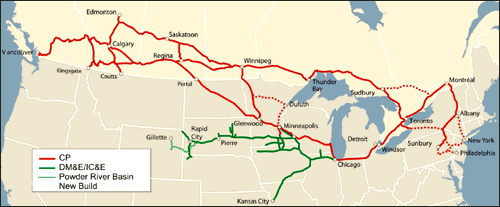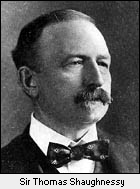 |
Fall 2008
|
Canadian Pacific has Strong Roots in
the US

 CP was the first railway to truly
embrace the principles of the North AMerican Free Trade Agreement, decades before NAFTA's three partner nations even
entertained such a notion. CP was the first railway to truly
embrace the principles of the North AMerican Free Trade Agreement, decades before NAFTA's three partner nations even
entertained such a notion.
As early as January 1883, CP became the first foreign-owned company to be listed on the New York Stock
Exchange. Two months later, we were also on the London ( UK ) stock exchange. That same year, CP made its first
physical incursion into the US, when the railway gained control of the South Eastern Railway in southern Quebec,
with a link to Newport, Vermont; and our close cross-border relationship has grown ever since.
Men, money, and most other resources moved freely between the United States and Canada. Even CPR's legendary
builder, Sir William Cornelius Van Horne, was an import, having been lured from his job as general manager of the
Milwaukee & St. Paul.
While the Canadian transcontinental main line was still under construction to the Pacific Ocean, CP interests were
building and securing what would become the Soo Line, south of the border. Cross-border connections at
Emerson, Manitoba, and North Portal, Saskatchewan, extended CP's reach into the upper US Midwest.
The value of the relationship was enhanced even further when the Soo Line entered the Chicago market in 1909.
Famous name trains like the "Mountaineer" and the "Soo-Dominion" would go on to
carry thousands of tourists from the Windy City and the Twin Cities of Minneapolis and St. Paul to resorts in the
Canadian Rockies.
Our connections with the Milwaukee Road run just as deep. Both CP's second and third presidents - Van Horne and Sir
Thomas Shaughnessy, respectively - were recruited from there. The Milwaukee became a major railroad in the US during
the 19th century and a transcontinental one in the 20th century. Along the way, it became famous for operating some
of the world's fastest, most efficient passenger trains. When poor economic conditions for Midwestern railroading
forced the Milwaukee to focus on its core of sustainable lines, it was sold to the Soo Line, in 1984.
 The Toronto, Hamilton & Buffalo ( TH&B ) was built in the 1890s to allow businesses in the Hamilton area to
ship products to customers in Toronto and Montreal and to American customers via Buffalo. The TH&B was jointly
owned, after 1895, by the CPR and the New York Central ( and its successor, Penn Central ). CP and the New York
Central ran a through service in the Chicago-Detroit-Toronto corridor. We also interchanged traffic at
Montreal. CP purchased all the shares of the TH&B in 1977. Ten years later, all of the TH&B operations were
integrated with the parent railway.
The Toronto, Hamilton & Buffalo ( TH&B ) was built in the 1890s to allow businesses in the Hamilton area to
ship products to customers in Toronto and Montreal and to American customers via Buffalo. The TH&B was jointly
owned, after 1895, by the CPR and the New York Central ( and its successor, Penn Central ). CP and the New York
Central ran a through service in the Chicago-Detroit-Toronto corridor. We also interchanged traffic at
Montreal. CP purchased all the shares of the TH&B in 1977. Ten years later, all of the TH&B operations were
integrated with the parent railway.
The Delaware & Hudson is the oldest continuously operating transportation company in North America. In 1823, it
started as a canal company. In 1829, it entered the railroad business; and, in 1840, it became the first
transportation company to be traded on the New York Stock Exchange. In 1907, D&H extended its lines into Canada
to connect with CP at Farnham, Quebec. Known as "The Bridge Line", the D&H gave CP a bridge to other
Class I's in the US northeast and access to markets in and around New York City.
 Following a decline in industrial traffic in the Northeast, and the inability of a succession of rail interests to
make a go of it, CP acquired the D&H, in 1991, and has invested more than $200 million on infrastructure
improvements in the interim.
Following a decline in industrial traffic in the Northeast, and the inability of a succession of rail interests to
make a go of it, CP acquired the D&H, in 1991, and has invested more than $200 million on infrastructure
improvements in the interim.
With the acquisition of the DM&E and IC&E, CP gets a strategic end-to-end addition to its rail
system and a more solid presence in the US Midwest than ever before. "The DM&E is a
high-quality", growing regional railroad, that complements our existing franchise", said Fred
Green, CP's president and chief executive officer. "This investment also presents us with the opportunity for
future growth through further expansion of our network".
The addition of the DM&E and IC&E extends the reach of CP's network, adding new customers and expanding the
service available to customers on both sides of the border. The DM&E system is the largest regional railroad in
the US and the only Class II that connects and interchanges traffic with all seven Class I railroads, connecting
with CP at Minneapolis, Winona, and Chicago.
Our cross-borderbonds have never been stronger.
This Momentum article is copyright
2008 by the Canadian Pacific Railway and is reprinted here with
their permission. All photographs, logos, and trademarks are the property of the Canadian Pacific Railway
Company.
|